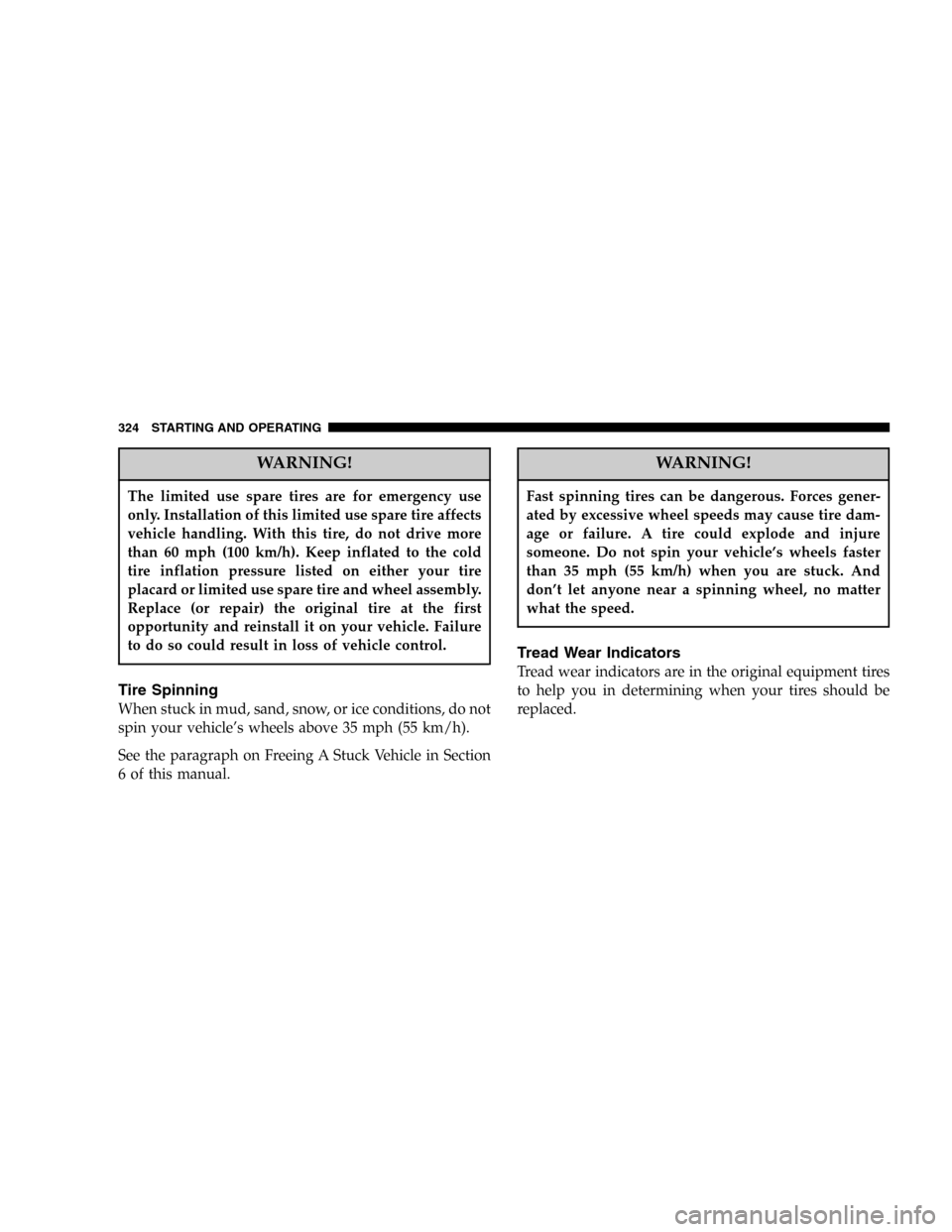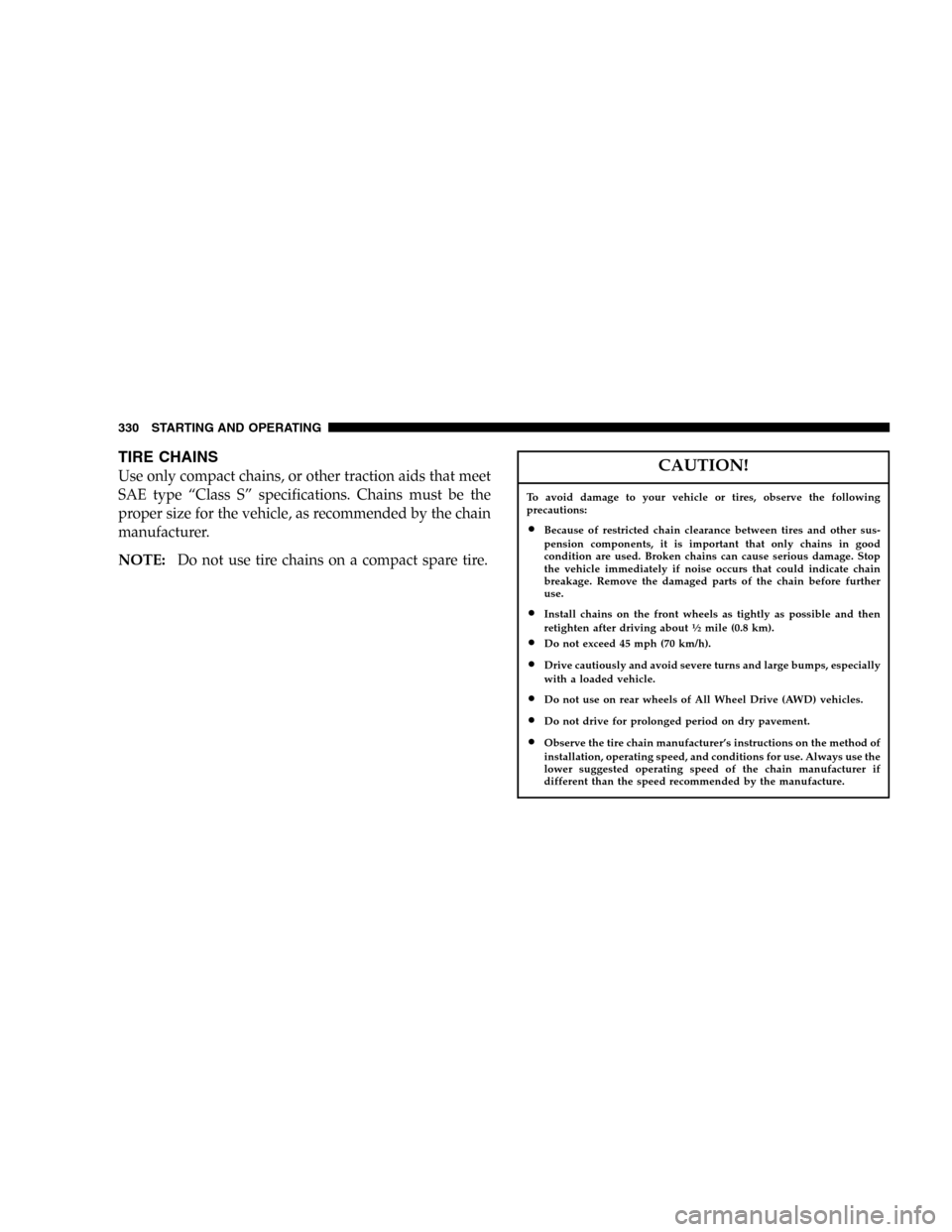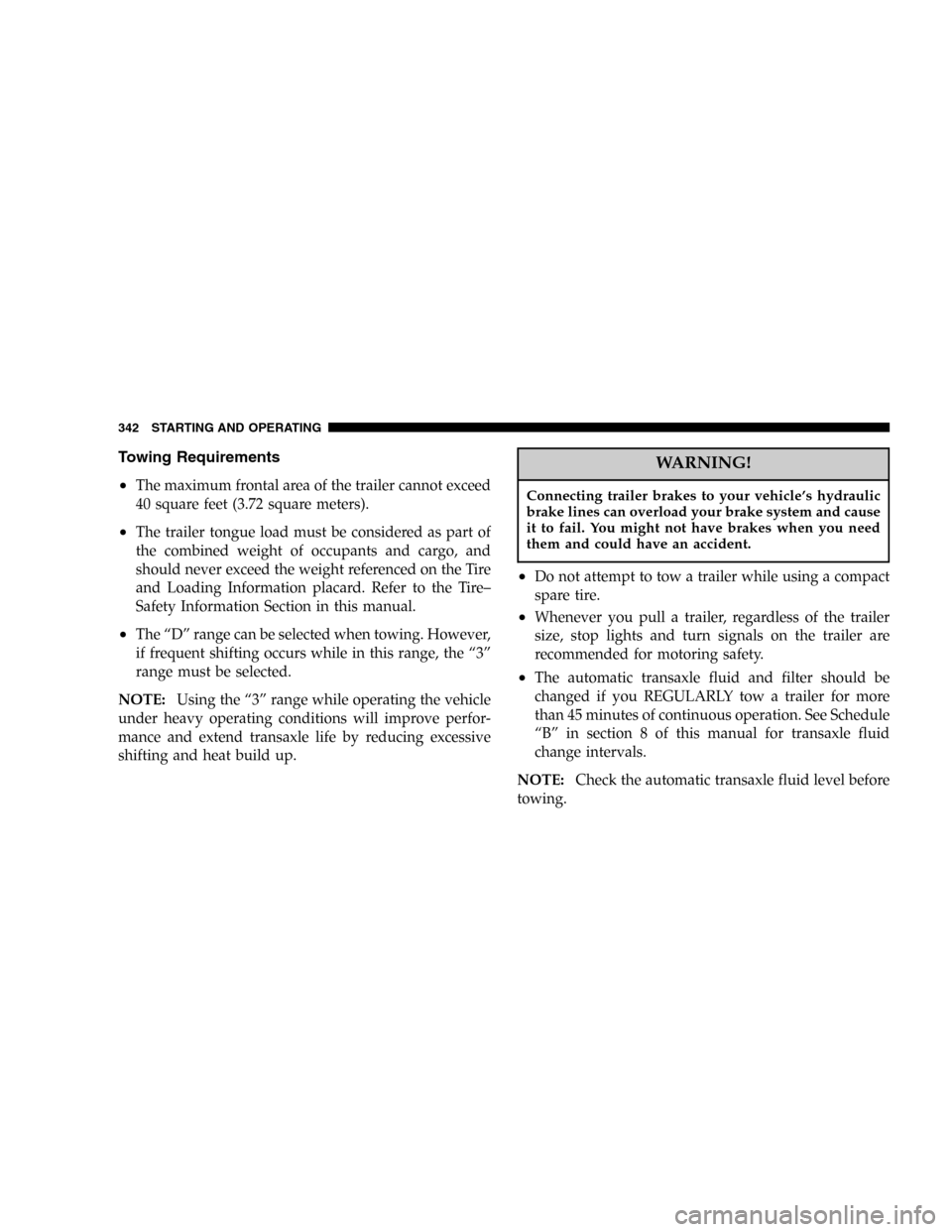Page 324 of 472

WARNING!
The limited use spare tires are for emergency use
only. Installation of this limited use spare tire affects
vehicle handling. With this tire, do not drive more
than 60 mph (100 km/h). Keep inflated to the cold
tire inflation pressure listed on either your tire
placard or limited use spare tire and wheel assembly.
Replace (or repair) the original tire at the first
opportunity and reinstall it on your vehicle. Failure
to do so could result in loss of vehicle control.
Tire Spinning
When stuck in mud, sand, snow, or ice conditions, do not
spin your vehicle’s wheels above 35 mph (55 km/h).
See the paragraph on Freeing A Stuck Vehicle in Section
6 of this manual.
WARNING!
Fast spinning tires can be dangerous. Forces gener-
ated by excessive wheel speeds may cause tire dam-
age or failure. A tire could explode and injure
someone. Do not spin your vehicle’s wheels faster
than 35 mph (55 km/h) when you are stuck. And
don’t let anyone near a spinning wheel, no matter
what the speed.
Tread Wear Indicators
Tread wear indicators are in the original equipment tires
to help you in determining when your tires should be
replaced.
324 STARTING AND OPERATING
Page 327 of 472

Improper alignment will not cause vehicle vibration.
Vibration may be a result of tire and wheel out-of-
balance. Proper balancing will reduce vibration and
avoid tire cupping and spotty wear.
TIRE PRESSURE MONITOR SYSTEM—IF
EQUIPPED
The Tire Pressure Monitor System (TPM) system uses
wireless technology with wheel rim mounted electronic
sensors to monitor tire pressure levels (EXCLUDING
THE SPARE TIRE). Sensors, mounted to each wheel as
part of the valve stem, transmit tire pressure readings to
a receiver located in the instrument panel.
NOTE:The tire pressure monitoring system on your
vehicle will warn you when one of your tires is signifi-
cantly underinflated and when some combinations of
your tires are significantly underinflated. It is particularly
important, therefore, for you to check the tire pressure in
all of your tires regularly and maintain proper pressure.
1,2,3, OR 4 TIRE(S) LOW PRESSURE
Low tire pressure levels of 28 psi [1.9 bars] (193 kPa) or
less detected in one or more tires.
Inspect all tires for proper inflation pressure, once proper
tire pressure has been set the TPM system warning will
reset automatically once ignition switch has been turned
ON.
1,2,3, OR 4 TIRE(S) HIGH PRESSURE
High tire pressure levels of 48 psi [3.3 bars] (330 kPa) or
more detected in one or more tires.
Inspect all tires for proper inflation pressure, once proper
tire pressure has been set the TPM system warning will
reset automatically once ignition switch has been turned
ON.
STARTING AND OPERATING 327
5
Page 330 of 472

TIRE CHAINS
Use only compact chains, or other traction aids that meet
SAE type“Class S”specifications. Chains must be the
proper size for the vehicle, as recommended by the chain
manufacturer.
NOTE:Do not use tire chains on a compact spare tire.CAUTION!
To avoid damage to your vehicle or tires, observe the following
precautions:
•Because of restricted chain clearance between tires and other sus-
pension components, it is important that only chains in good
condition are used. Broken chains can cause serious damage. Stop
the vehicle immediately if noise occurs that could indicate chain
breakage. Remove the damaged parts of the chain before further
use.
•Install chains on the front wheels as tightly as possible and then
retighten after driving about1⁄2mile (0.8 km).
•Do not exceed 45 mph (70 km/h).
•Drive cautiously and avoid severe turns and large bumps, especially
with a loaded vehicle.
•Do not use on rear wheels of All Wheel Drive (AWD) vehicles.
•Do not drive for prolonged period on dry pavement.
•Observe the tire chain manufacturer’s instructions on the method of
installation, operating speed, and conditions for use. Always use the
lower suggested operating speed of the chain manufacturer if
different than the speed recommended by the manufacture.
330 STARTING AND OPERATING
Page 342 of 472

Towing Requirements
•
The maximum frontal area of the trailer cannot exceed
40 square feet (3.72 square meters).
•The trailer tongue load must be considered as part of
the combined weight of occupants and cargo, and
should never exceed the weight referenced on the Tire
and Loading Information placard. Refer to the Tire–
Safety Information Section in this manual.
•The“D”range can be selected when towing. However,
if frequent shifting occurs while in this range, the“3”
range must be selected.
NOTE:Using the“3”range while operating the vehicle
under heavy operating conditions will improve perfor-
mance and extend transaxle life by reducing excessive
shifting and heat build up.
WARNING!
Connecting trailer brakes to your vehicle’s hydraulic
brake lines can overload your brake system and cause
it to fail. You might not have brakes when you need
them and could have an accident.
•Do not attempt to tow a trailer while using a compact
spare tire.
•Whenever you pull a trailer, regardless of the trailer
size, stop lights and turn signals on the trailer are
recommended for motoring safety.
•The automatic transaxle fluid and filter should be
changed if you REGULARLY tow a trailer for more
than 45 minutes of continuous operation. See Schedule
“B”in section 8 of this manual for transaxle fluid
change intervals.
NOTE:Check the automatic transaxle fluid level before
towing.
342 STARTING AND OPERATING
Page 348 of 472

WARNING!
A hot engine cooling system is dangerous. You or
others could be badly burned by steam or boiling
coolant. You may want to call a service center if your
vehicle overheats. If you decide to look under the
hood yourself, see Section 7, Maintenance, of this
manual. Follow the warnings under the Cooling
System Pressure Cap paragraph.
JACKING AND TIRE CHANGING
WARNING!
•Getting under a jacked-up vehicle is dangerous. The
vehicle could slip off the jack and fall on you. You
could be crushed. Never get any part of your body
under a vehicle that is on a jack. If you need to get
under a raised vehicle, take it to a service center
where it can be raised on a lift.
•The jack is designed to use as a tool for changing
tires only. The jack should not be used to lift the
vehicle for service purposes. The vehicle should be
jacked on a firm level surface only. Avoid ice or
slippery areas.
•For vehicles equipped with fold-in-floor seating, if it
is necessary to retrieve the spare tire from under the
vehicle on the side of the vehicle close to moving
traffic. Pull far enough off the road to avoid the
danger of being hit.
348 WHAT TO DO IN EMERGENCIES
Page 350 of 472
Jack Location—Fold-in-Floor Seating
The jack, jack handle and winch handle tools are stowed
behind the rear left side trim panel in the rear cargo area.
Pull up on the lever to release the cover.Remove the scissors jack and jack handle by rotating the
small wing nut to the left. Also remove the tool pouch
containing the spare tire winch handle tools, which is
located next to the jack and jack handle.
Jack LocationJack Removal/Installation
350 WHAT TO DO IN EMERGENCIES
Page 351 of 472
Spare Tire Stowage—Fold-in-Floor Seating
For vehicles equipped with fold-in-floor seating, the
spare tire is stowed inside a protective cover located
under the center of the vehicle by means of a cable winch
mechanism. The“spare tire drive”nut is located on the
floor, under a plastic cap between the front seats.
The tool pouch contains three pieces and can be as-
sembled into a Spare Tire Hook to remove the compact
spare tire/cover assembly from under the vehicle or a
Winch“T”Handle to raise/lower the compact spare
tire/cover assembly.
WHAT TO DO IN EMERGENCIES 351
6
Page 352 of 472
Jacking Instructions—Fold-in-Floor Seating
1. Loosen (but do not remove) the wheel lug nuts by
turning them to the left one turn while the wheel is still
on the ground.
2. To remove the compact spare tire/cover assembly,
assemble the winch handle extensions to form a“T’and
fit the winch“T”handle over the drive nut. Rotate the
nut to the left approximately 33 turns until the winch
mechanism stops turning freely, this will allow enough
slack in the cable to allow you to pull the spare tire out
from under the vehicle.
Spare Tire Removal
352 WHAT TO DO IN EMERGENCIES